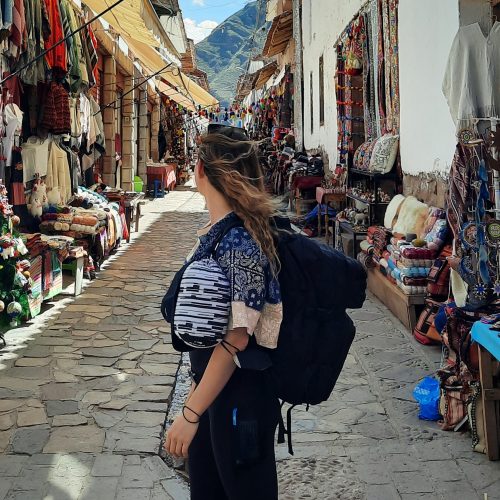Getting around Costa Rica
TRAVEL DATE : MAY/ JUNE 2022
Costa Rica has many routes and bus companies, so it is absolutely possible to get around the country by public transport. Although the important number of different companies can make it confusing, so here is how we managed to visit Costa Rica by bus.
Note that prices displayed here are not official and can vary depending on the time of booking and visit. See here the itinerary we took, but note there is many other places you can reach by bus.
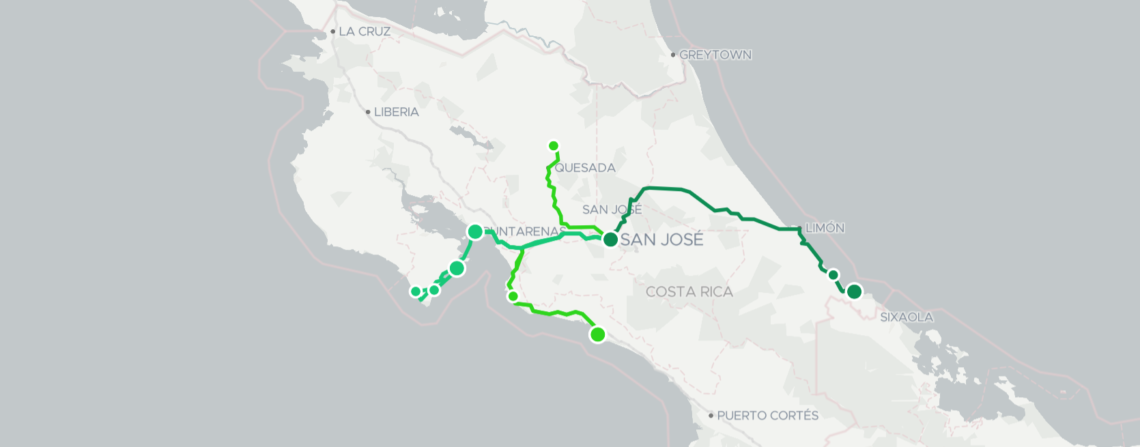
There is no official website gathering all bus timetables in one place. You have to check each companie’s website and they are not always displaying information. Luckily, this one guy created a non-official website, with many routes (work still in progress), and he updates the information regularly so you can usually trust the displayed information: The Bus in Costa Rica.
Tickets can’t be purchased online, only at the bus stations or when boarding the bus. If you board a bus for just a part of the journey, they always adapt the amount you have to pay. Anyway buses are very affordable. Never fully trust the travelling time, Costa Rican traffic jams can impact on the journey a lot, so never plan transfers too tight. Careful, many towns have the same names (there is a Manzanillo on the Caribbean Coast and on the Pacific Coast). If you can’t find the information you are looking for online, don’t hesitate to write to the bus companies on Facebook or WhatsApp, I did it twice and they replied fast.

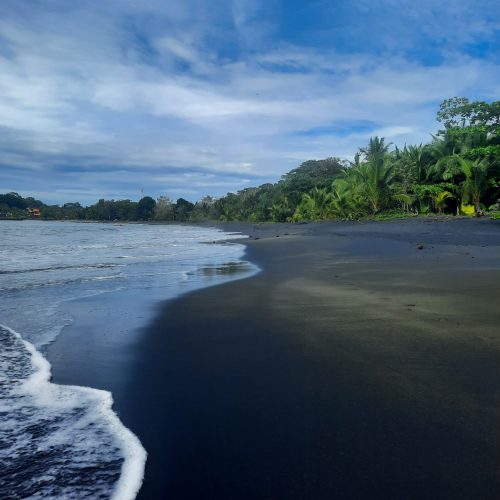

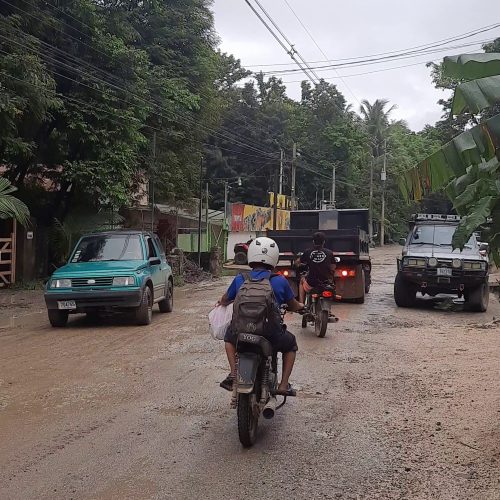
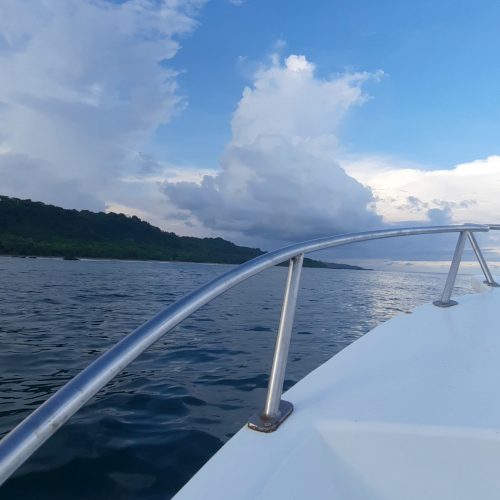






Get from the Airport in Alajuela to the city center of San José
When exiting the airport, pass the thousands taxi drivers offering their services and cross the road to the parking lot. Once on the opposite curb, take left and go around the parking, you will find here the bus stop for the Tuasa buses (red buses). They are not all going to the city center of San José so make sure to ask your driver before stepping in the bus “Vas a la ciudad de San José?”. The journey takes about 45 minutes, costs around ₡700 = 1 USD (pay when boarding the bus) and buses are passing by every 10 to 20 minutes. To get back to the airport, same dance, but this time the bus leaves from Terminal Tuasa San José – Alajuela.
Get around the Caribbean Coast
(San José – Puerto Viejo de Talamanca – Manzanillo – Cahuita)
- From San José, the company MEPE can take you to Cahuita or Puerto Viejo. Find here the timetable. You can purchase your bus ticket at the bus station (Avenue 9, Paso De La Vaca, San José). A journey of approximately 6 hours will take you to Puerto Viejo for ₡6160 = 9 USD. The bus stop is located by the beach.
- At Puerto Viejo bus station, you can find the bus timetable and get your ticket to head to Manzanillo, it is around ₡700 = 1 USD, 40 min long journey and the bus is going about 5 times a day. This bus is coming from Limon, so expect it to be a little late. Before exiting the bus in Manzanillo, make sure to take a picture of the timetable displayed in the bus for your way back. The town is small, the bus stop is in the middle of the road.
- When you leave, the bus should be on time as it is the beginning of the bus’s journey, and you can pay your ticket on board. The bus is going to Limon, this time you can stay in the bus until Cahuita. When you exit the bus in Cahuita, first check the timetable displayed at the bus ticket counter.
- From there, you can decide to make it straight back to San José or stop in Limon and head to Tortugero.
Get around Nicoya Peninsula
(San José – Santa Teresa – Montezuma)
- From San José Terminal 710 (Calle 8, Paso De La Vaca), Transportes Cóbano will take you across the Nicoya Golf. See here itinerary options and timetable. In the bus terminal, their office is located underground (I know, super odd). Get your ticket to Cóbano and catch your bus. The bus driver will drop you in front of the ferry, give you your ferry tickets and get you back after the ferry ride across the golf. The journey is around 5 hours and cost ₡7500 = 11 USD.
- Once in Cabano, head to this bus stop and catch the Transportes Malpaís company’s bus. The ticket to Santa Teresa costs ₡1000 = 1,5 USD (pay when boarding) and the journey is about 1 hour (depending on traffic). The road is very bumpy. As Santa Teresa is built on a very long road, you can ask a stop pretty much anywhere along the road.
- When leaving, you must wait along the road again and wave when the bus passes by. See here the times when the bus leaves Playa Hermosa, but you can’t really know how long it will take to reach the spot where you are waiting from. Head back to Cóbano and catch the bus to Montezuma from the same bus stop.
- When it was time to leave Montezuma, I couldn’t find any timetable, so I messaged the Transportes Cóbano company via Facebook and they replied super-fast with this timetable. We then caught the bus from Montezuma to Paquera, and then the ferry to Punta Arenas.
Getting down the Pacific Coast
(Punta Arenas – Quepos – Manuel Antonio – Jaco – San José)
- Note that when you exit the Ferry, the bus stop (street C.1) for the Transportes Quepos Puntarenas buses is about 25-minute walk. See here the timetable and prices, purchase tickets when boarding. You can catch a bus straight to Quepos or stop in Jaco. In Jaco, buses drop you along the main road (ask for stop), and same for pick up. In Quepos, there is a bus station at Terminal de Buses de Quepos.
- To head to Manuel Antonio, the buses are leaving Quepos from 5:30am to 9:30pm every 20min, the journey takes 20 minutes and costs ₡335 = 0,5 USD.
- Head back to San José with Transportes Jaco, leaving from Terminal de Autobuses de San José, purchase tickets at bus office. The journey takes about 3 hours and costs ₡2600 = 3,8 USD. Or continue your journey to Corcovado Area.
Getting around Alajuela
(Vara Blanca – La Paz Waterfall – Poas Volcano)
Unfortunately, our favourite website isn’t displaying any information for this part of Costa Rica and it seems like it is a tricky area to get around anyway…
What we did was use the company Grupo Caribeños going from San José from Puerto Viejo de Sarapiqui and hopped off in Vara Blanca where our accommodation was. To get the timetables, I contacted the company on Facebook and an automatic message came back with links to their timetables (which are displayed on WhatsApp). Once in Vara Blanca, we used again the same bus line to go up and down the road. The only issue: this bus is only going pass 3 times a day, and you never really know the exact time as all you know is that it is taking minimum 2 hours from San José to Vara Blanca / 2 hours from Puerto Viejo de Sarapiqui to Vara Blanca. Plus, on the day we needed to head back to San José, the bus passed without stopping as it was full. Anyway, if you read my blog about our journey in Costa Rica, you know I don’t really recommend this specific area if you don’t have a car.
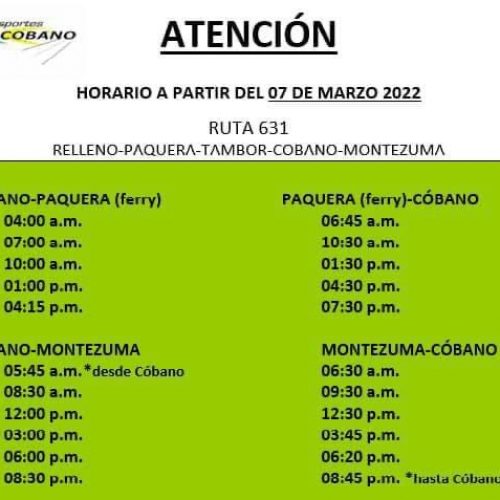
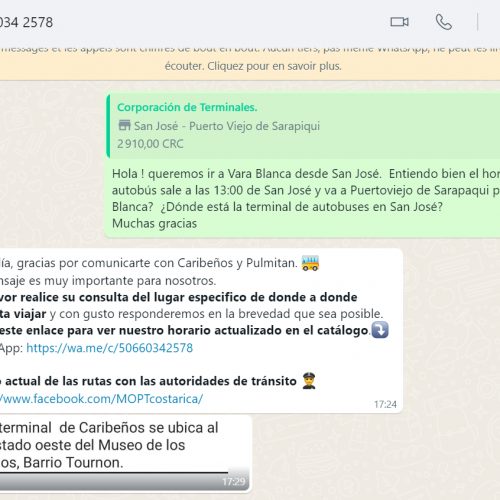

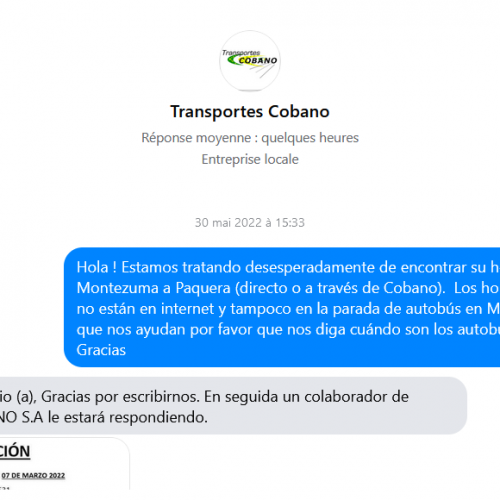






Taxis
We actually used Uber much more when we needed transfer from a bus station to our destination,it was cheap and reliable. If you want to go with a taxi, always choose an official taxi (they have to have a number written on the car) and agree on the price before stepping in the taxi “Que es el precio para ir a …?”. When exiting the airport or a bus station, it is common to be surrounded by taxi drivers offering their service, they can be quite insistent, and it can get quickly overwhelming. We would usually decline all and step further, so we could get to the road where the drivers were waiting in their taxis, and actually check the taxi was displaying the official number.
We also had a very unpleasant encounter with a Taxi driver: arriving to the 710 bus station in San José, a man offered hand sanitizer before we could enter in the bus station, making me think he was working for the bus station. He asked where we were going and started saying that our bus left 5 minutes ago, that he could drive us to another bus station where another bus was heading where we needed to go, but it was leaving in 5 minutes so we should hurry. Hahaha right, that’s when you catch he was a taxi driver trying to trick us. We stepped in the bus station and our bus wasn’t gone at all. So be careful! That’s when speaking Spanish comes handy …
Speaking Spanish
Most people working for tour companies, in restaurants, hostels, etc. speak good English. But it is still super useful to speak a little Spanish, especially to communicate with bus drivers. So practice before your trip!


